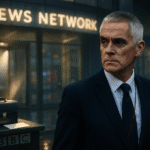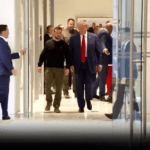In a dramatic and unprecedented Oval Office meeting on February 28, 2025, President Donald Trump and Vice President JD Vance engaged in a heated confrontation with Ukrainian President Volodymyr Zelenskyy. The encounter, intended to solidify a critical minerals agreement between the United States and Ukraine, devolved into a contentious exchange that has cast a shadow over the future of U.S.- Ukraine relations and the broader geopolitical landscape.
The meeting commenced with formal pleasantries but quickly escalated into a verbal clash. President Trump and Vice President Vance accused President Zelenskyy of ingratitude toward U.S. support and of obstructing potential peace negotiations with Russia. The situation intensified when Vice President Vance questioned Zelenskyy’s approach, suggesting he was being “disrespectful” by challenging the administration’s diplomatic efforts.
President Trump further admonished Zelenskyy, stating, “You’re gambling with World War III,” and emphasized that without U.S. support, Ukraine lacked leverage in negotiations.
The Crux of the Dispute
At the heart of the discord was a proposed agreement granting the U.S. access to Ukraine’s valuable mineral resources. This deal was envisioned to finance Ukraine’s reconstruction and strengthen economic ties between the two nations.
However, President Zelenskyy expressed reservations, arguing that economic incentives without explicit security guarantees would leave Ukraine vulnerable to further Russian aggression. He highlighted Russian President Vladimir Putin’s history of violating ceasefire agreements, asserting that a mere ceasefire would be insufficient to ensure lasting peace.
The confrontation was notably public, with the leaders’ heated exchange unfolding before the press. President Trump, visibly agitated, accused Zelenskyy of harboring “tremendous hatred” for Putin, suggesting that such animosity hindered diplomatic progress.
Vice President Vance echoed this sentiment, pressing Zelenskyy to express gratitude for U.S. efforts and questioning his commitment to peace. The meeting concluded abruptly, with President Trump instructing Zelenskyy to leave the White House and declaring on social media that Zelenskyy could return “when he is ready for peace.”
Implications for U.S.-Ukraine Relations
This incident marks a significant departure from previous U.S. policy toward Ukraine. The Trump administration’s approach, emphasizing economic agreements over military support and explicit security assurances, has introduced uncertainty into the U.S.-Ukraine alliance.
European allies have expressed concern over this shift, fearing it may embolden Russian aggression and destabilize the region further. The suspension of the minerals deal not only hampers Ukraine’s economic recovery efforts but also signals a potential reevaluation of U.S. involvement in Eastern European security matters.
The strained dynamics between President Trump and President Zelenskyy are not without precedent. During Trump’s previous term, interactions with Ukraine were marred by controversies, including allegations that Trump pressured Zelenskyy for political favors, leading to his first impeachment. These historical tensions have resurfaced, complicating diplomatic engagements and casting doubt on the prospects for a unified strategy to address Russian hostilities.
The fallout from this Oval Office confrontation extends beyond bilateral relations. It raises critical questions about the United States’ role in global conflict resolution and its commitment to supporting allies under threat. The apparent discord and lack of cohesive strategy may undermine international confidence in U.S. leadership, potentially prompting allies to seek alternative security arrangements.
Moreover, the incident could embolden adversarial nations to exploit perceived divisions within Western alliances. The heated exchange between President Trump and President Zelenskyy underscores the complexities inherent in international diplomacy, especially when national interests and global security are at stake.



















